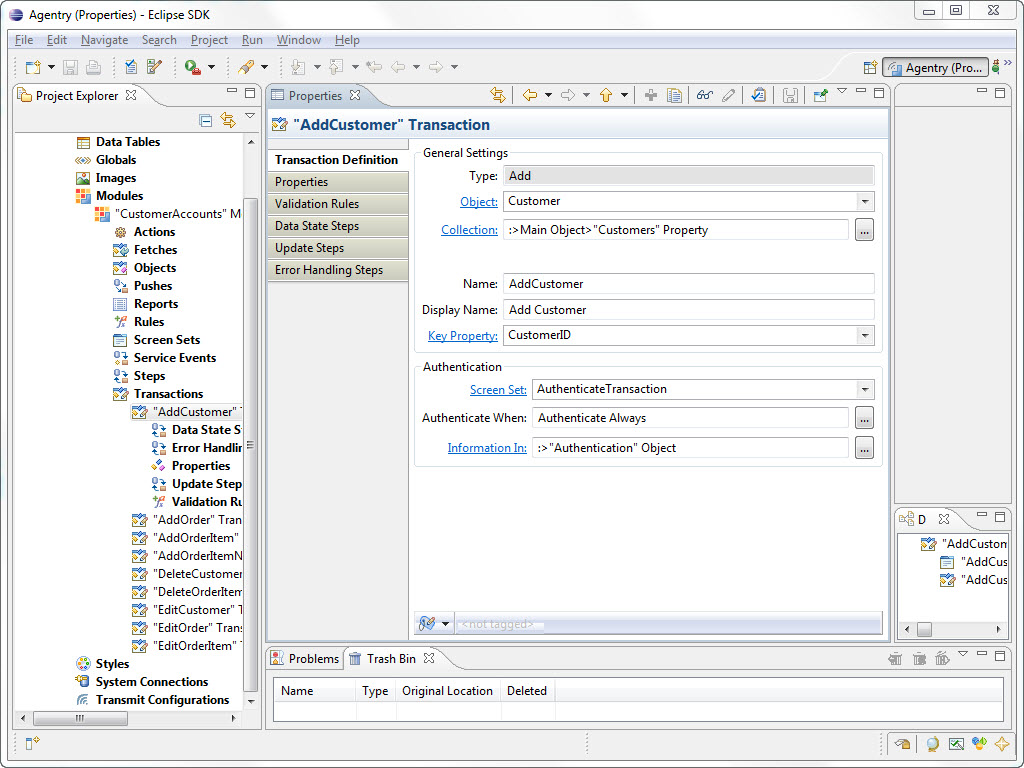Prerequisites
The following items should be addressed prior
to performing this procedure:
- Determine if the transaction
should require authentication at all times or conditionally. If conditionally,
determine the specific conditions and the values on the client involved
in the determination to support the creation of the rule definition
that will be needed.
- Determine the requirements for the audit trail and/or electronic
signature information dictated by the back end system, including
what information is needed and how it should be recorded. Note this
information to support the logic needed in the back end processing for
the transaction as well as in the definition of the authentication
object and its properties.
Task
This procedure provides guidance and information on
implementing transaction authentication. The steps here include
the main process to be followed as well as guidance on variations
to these standards, which may be implemented depending on need.
The main process presented here is the recommended best practice
for implementing this functionality.
- Begin by defining an object, preferably named
“Authentication”. Add to this object the properties needed to capture
the values required for the transaction(s) for which it is to be used.
If capturing the password for the user, define a string property
for this purpose and set that property’s Password attribute
to true. This will prevent the value of this field from being displayed
on the client, and protect it from being displayed in log files
and other potentially non-secure locations.
As an alternative, it is possible to capture the authentication
information in the properties of the transaction. However, the use
of a separate object is the recommended method as it is easier to
define and better supports conditional authentication.
- Next define a screen to set to display the Authentication
object definition. Add to it the platform(s) needed for the environment.
Finally, define the detail screens and fields to display the properties
from the Authentication object. Do not add button definitions to
this screen set, as it will be displayed as a wizard screen set
and the client will display the buttons needed automatically.
- The transaction for which the authentication behavior
can now be modified. Navigate to the transaction and view the main
Transaction Definition tab in the Properties View. In the Authentication
section of this tab set the authentication attributes for Screen
Set, Authenticate When, and Information In, as shown in the following
example:

If storing authentication values in the transaction properties
rather than a separate object, be sure to leave the default Information
In attribute setting of “Properties of this transaction.” Also,
the Authenticate When attribute is where a rule can be defined and referenced.
Remember the rule is evaluated in a Boolean context with a true
result requiring authentication.
At this point it is possible to publish this application
and test the client-side behavior of the transaction authentication.
Note that authentication-related data captured at this point will
not be processed to the back end system.
- OPTIONAL: If condition transaction authentication
is defined, a property should be added tot he transaction itself
to be used as a flag indicating whether or not the authentication
was performed for the transaction instance. The recommended practice
is to define a Boolean property and to set the property to be initialized
by a rule. In most cases the rule used to determine if the authentication
should occur can also be used to initialize the Boolean property.
- The final part of the transaction authentication is to
define the logic to process the authentication data to the back
end system. This is specific to the back end system’s requirements
for such information. When defining the step, authentication-related
data is accessed using the SDML data tags <<transaction.authenticationObjectName.propertyName>>.
For Java system connections, the values can be accessed in the TransactionSession class
using the get methods and passing in the property names in the form transaction.authenticationObjectName.propertyName.
In either syntax, the name of the object and the name of the property
are used. The other standard transaction values, including properties
and the transaction’s time stamp are also accessible. Once the step
is defined it can be run as a server update step within the transaction.
If performing conditional authentication on the client, be sure
the logic to process the authentication data checks the flag property
value in the transaction to determine if the transaction was authenticated
or not.
With the completion of this procedure, the transaction
has been defined to require the user to authenticate themselves
on the client before the transaction is applied and saved. Depending
the specifics of the configuration, the authentication may be conditional.
Next
Once this procedure is complete, the behavior should
be thoroughly tested in an appropriate environment. Testing should
include verification of the client-side behavior, especially any
and all scenarios related to conditional authentication. Back end
processing should also be verified as accurate and again scenarios
should factor in any conditional authentication.
